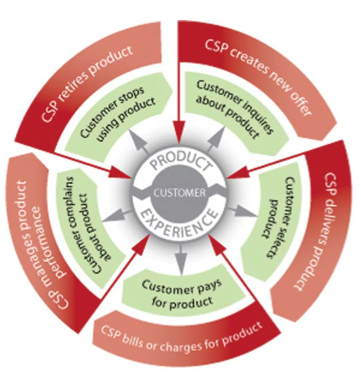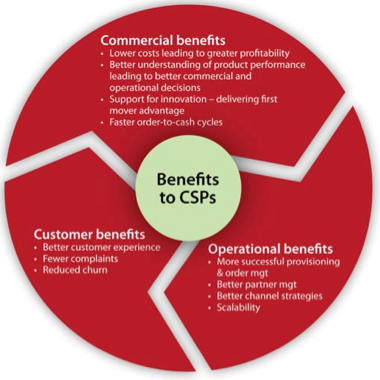The Communication Service Provider (CSP) industry is currently awash with talk aboutthe importance of optimising the customer experience. The customer experience isconsidered to be a key area of differentiation, and delivering a good customer experience as essential for those CSPs who wish to retain existing customers and attract new ones from rivals. Ernest Margitta explains how that starts with optimising the product experience
The Communication Service Provider (CSP) industry is currently awash with talk about the importance of optimising the customer experience. The customer experience is considered to be a key area of differentiation, and delivering a good customer experience as essential for those CSPs who wish to retain existing customers and attract new ones from rivals. Ernest Margitta explains how that starts with optimising the product experience
To truly optimise the customer experience, thereis a vital dependency on optimising the product experience. The product experience is what underpins a satisfying customer experience: the products are what drive a customer to engage with a service provider; the diversity and attractiveness of offers and services are what generate additional revenue; and the quality and consistency of the use of those products is what keeps the customer loyal.
Ultimately, the customer experience is substantially defined by the customer’sinteraction with the CSP’s products, frompurchase to delivery, to use and to payment. At the same time, communications products and services are no longer static, long-lived or few innumber. CSPs are increasingly defined by the products they offer and, to stay competitive anddeliver against customer expectations, they must manage and refresh a complex and dynamicproduct portfolio. And to add further pressure,the increasingly competitive CSP market requiresthat service providers closely monitor how their products are performing, so that they can makebetter commercial and strategic decisions and continually evolve their product strategy.
The business challenge behind the experience comes down to a basic premise: what should I be selling to my customers and what do I need to do to effectively deliver and manage that? So the successful retailers that deliver on customer experience are the ones adept at product management and at understanding the relationship between customers’ wants and needs and the products designed to fulfil them. However, delivering on this targeted style of customer management on a large scale is only possible through an ‘industrial’ – or automated and scalable – approach to designing and managing products; not through the ‘artisan’ – or labour-intensive – approach we commonly see throughout the industry
The central role of product in the customer experience
When we consider what the customer experience actually involves we quickly discover this is arather more complex question than it first appears. It encompasses far more than just customer service or customer service channels, as important as these are to the customer experience. Rather it is defined by the sum of all the touchpoints a customer has with a CSP.
There are in fact a wide variety of touch points that together create the customer experience. The common element throughout an end-to-end experience, as Figure 1 shows, is the product: the product is being offered, sold, provisioned, used, billed for or enquired about at a given touchpoint. The lure of a particular product offeris often what attracts a customer to a CSP in the first place. How these products perform in terms of delivering against the customer’s evolving wants, needs or desires contributes substantially to customer satisfaction, retention, lifetime spending and support costs.

Fig 1 – The central role of the product in the customer experience
Why the product experience needs to be explicitly managed
The central role of product in the customer experience makes it essential that CSPs have explicit control over the entire end-to-end lifecycle of products, as well as having accurate and timely insight into how these are performing operationally, commercially and from the customer’s point-of-view.
However, delivering this level of insight is often far from trivial, since the concept of ‘product’ is fragmented throughout the order-to-install-tocash- to-care process. Moreover, the proliferation of CSP products, the increasing velocity of product rollout, the speed of change and decreasing product lifespans mean that CSPs need to centrally and explicitly manage products.
It is now broadly recognised that using a common reference of product information throughout the selecting, buying, using, paying and customer care phases holds the key to centralised control and effective management. And with the product portfolio central to running the business itself, the requirements are obvious: a product management strategy that delivers simplification and accuracy; standardisation with flexibility, reliability and low cost.
Delivering this type of centralised product management not only optimises the product experience, but also increases operational efficiency in a wide range of processes and supports greater commercial agility.
The benefits of delivering a better product experience
Understanding, and ultimately managing, the key role that the product plays in the customer experience delivers a wide range of commercial, operational and customer benefits, as shown in Figure 2.
Making the case for such an approach can be challenging, however, if trying to quantify thetotal losses as a result of a sub-optimal product experience: direct losses (such as highe operational costs and billing errors) are spread over a number of operational areas, while indirect costs – such as opportunity costs or suboptimal competitive positioning – are notoriouslydifficult to quantify.
Alternatively, the upside of such an approach can be more easily quantified and even proven.
By simplifying and explicitly managing the product in a single enterprise product catalogue, CSPs can deliver enormous benefits including lower costs, greater commercial and operational agility, and increased customer satisfaction. Investments aimed at improving the customer experience will be undermined if CSPs do not also invest in better product management, since the product experience is such an integral part of the customer experience. Likewise enhancing product management also complements investments made in business intelligence and analytics, as it supports a 360° view of products, enabling CSPs to monitor and optimise their performance.
The importance of the product to a successful commercial strategy, and to the customer experience, means that CSPs now urgently need to consider how they manage their products so as not to risk undermining both their strategic goals and investments.

Figure 2: Benefits derived from better product experience management.

Build the product experience by using product management to enhance customer satisfaction






